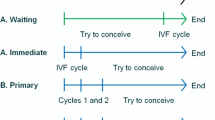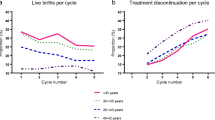Abstract
A 200-patient cohort has been established so that longitudinal analysis can determine the likelihood of an individual in vitro fertilization (IVF) entrant achieving a viable uterine pregnancy or a live baby. After a minimum of 39 months of access to repeated treatment cycles, 24% have achieved at least one viable pregnancy by undergoing an average of 2.48 treatment cycles per cohort member. Life-table analysis shows that most of these pregnancies have occurred in the first year after entering the program. Many members have undergone only one or two treatment cycles. In the future, greater emphasis will need to be placed on factors which encourage couples to undergo additional cycles of treatment. This, as much as technical advances, may increase outcome figures.
Similar content being viewed by others
References
Trounson A, Wood C: IVF results 1979–1982 at Monash University/Queen Victoria and Epworth Medical Centres. J Vitro Fert Embryo Transfer 1984;1:42–47
Edwards RG, Steptoe PCS: Current status of in vitro fertilization and implantation of human embryos. Lancet 1983;2:1265–1269
Edwards RG: Test-tube babies. Nature 1981;293:253–261
Wood C, Trounson A: In vitro fertilization and embryo transfer.In Recent Advances in Obstetrics and Gynaecology No. 19, J Bonnar (ed). London, Churchill Livingstone, 1982, pp 259–288
Rogers P, Molloy D, Healy D, McBain J, Howlett D, Bourne H, Thomas A, Wood C, Johnston I, Trounson A: Cross-over trial of superovulation protocols from two major in vitro fertilization centres. Fertil Steril 1986;46:424–431
Mahadevan MM, Trounson A, Leeton JF: The relationship of tubal blockage, infertility of unknown cause, suspected male infertility, and endometriosis to success of in vitro fertilization and embryo transfer. Fertil Steril 1983;40:755–762
Marrs R, Edwards R, Mashiach S, Suzuki, Lancaster P: Proceedings of 4th World Conference on in Vitro Fertilization, Melbourne, 1985, pp 1–2
Paterson PJ: Indication for the treatment of tubal infertility patients by microsurgery or IVF. Aust NZ J Obstet Gynaecol 1984;24:262–264
Hedon B, Dejean R, Daure JP, Marrs P, Valentin B, Viala JL, Durand D: In vitro fertilization and microsurgery. Acta Eur Fert 1983;14:17–22
Schoysman R: Tubal microsurgery versus in vitro fertilization. Acta Eur Fert 1984;15:5–13
Sundstrom P, Persson PH, Liedholm P, Wramsby HL: The ability of ultrasound to determine the time for harvesting preovulatory oocytes. Acta Obstet Gynecol Scand 1983;62:219–223
Lenz S, Lauritsen JG, Kjellow M: Collection of human oocytes for in vitro fertilization by ultrasonically guided follicular punctures. Lancet 1981;1:1163–1164
Lenz S, Lauritsen JG: Ultrasonically guided percutaneous aspiration of human follicles under local anaesthesia: A new method of collecting oocytes for in vitro fertilization. Fertil Steril 1983;38:673–677
Mao K, Wood C: Barriers to treatment of infertility by in vitro fertilization and embryo transfer. Med J Aust 1984;140:532–533
Kovacs GT, Rogers P, Leeton JF, Trounson AO, Wood C, Baker G: In vitro fertilization and embryo transfer—prospects of pregnancy by life table analysis. Med J Aust 1986;144:682–683
Trounson A, Caro C, Jessup D: The effect of maternal age on the success rate of in vitro fertilization. Proceedings of 16th Annual Conference, Australian Society for Reproductive Biology, 1984, p 55
National Perinatal Statistics Unit:In In Vitro Fertilization Pregnancies Australia and New Zealand 1979–1984, P Lancester (ed). Sydney, National Perinatal Statistics Unit, 1985, p 9
Asch RH, Balmaceda JP, Ellsworth LR, Wong PC: Gamete intrafallopian transfer (GIFT): A new treatment for infertility. Int J Fertil 1985;30:41–44
Author information
Authors and Affiliations
Rights and permissions
About this article
Cite this article
Paterson, P., Chan, C. What proportion of couples undergoing unrestricted in vitro fertilization treatments can expect to bear a child?. J Assist Reprod Genet 4, 334–337 (1987). https://doi.org/10.1007/BF01555381
Received:
Accepted:
Issue Date:
DOI: https://doi.org/10.1007/BF01555381




